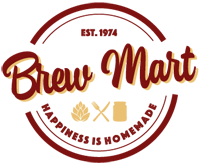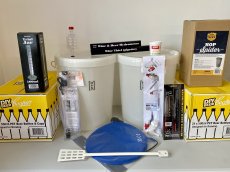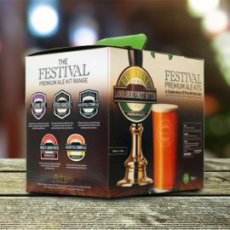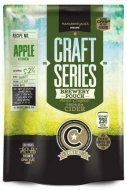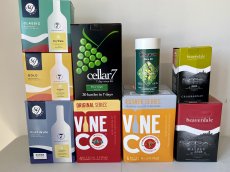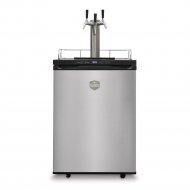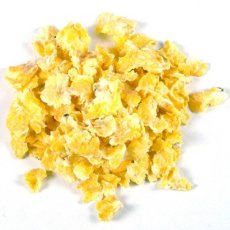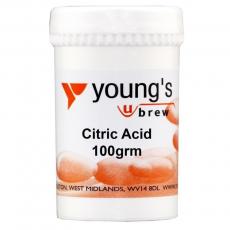Wine Glossary & Vocabulary
Acidity – one of the most important characteristics of wine: obtaining the correct acidity is all-important.
Acetification – Turning to vinegar
Aerobic fermentation – Fermentation is conducted in the presence of air. Usually, it is the first part of the fermentation process.
Alcohol – in wine, Ethyl alcohol
Ammonium phosphate – a popular yeast nutrient.
Ammonium sulphate –a popular yeast nutrient.
Anaerobic fermentation – A fermentation from which air is excluded; the second part of the fermentation process.
Aperitif – one taken before a meal to induce a good appetite.
Aroma – the smell of a young wine.
Bentonite – a diatomaceous earth or clay used as a wine fining or clarifier.
Body– the fullness of a wine.
Bouquet – the smell of a mature wine.
Camden tablets – useful in wine making for various sterilisation or purification purposes. They supply sulphur dioxide in a convenient form
Carbon dioxide – the colourless, orderless gas given off by a fermenting liquor.
Concentrate – the juice of white or red wine grapes, concentrated and sold in tins or packs
Country wines – wines made from fruit or ingredients other than grapes.
Demi John – another name for a 1-gallon jar.
Dessert wines – strong, full-bodied, full-flavoured wines drunk at the end of a meal with the dessert course
Dry – A wine is said to be dry when the fermentation has used up all the sugar in it;
It is also said to have fermented right out.
Enzyme – a protein catalyst used in winemaking and brewing to promote structural breakdown or ingredient changes. Petting-destroying enzymes are particularly useful in preventing jellification or cloudiness in fruit wines.
Fermenting (or working) - the process brought about by yeast acting upon sugar to produce alcohol and carbon dioxide.
Fermentation trap (or airlock) - a little gadget used to protect the fermentation from infection by the vinegar fly, also called a bubbler.
Filtration – clarifying wine using a filter, powder, paper, or pads.
Final gravity – the specific gravity when fermentation has finished.
Fining – removing suspended solids from a cloudy wine by adding wine finings.
Fortification – increasing the strength of wine beyond that possible by natural fermentation by adding spirit.
Gravity – an abbreviation of specific gravity, a scale used to measure the density of a liquid or, in wine-making usage, its sugar content.
Hydrometer - an instrument for measuring the weight (or sugar content) of a liquid.
Hydrometer jar – the jar in which the hydrometer is floated for a reading.
Initial gravity – the specific gravity at the outset of fermentation.
Lees – the deposit of yeast and solids formed during fermentation.
Magnesium sulphate (Epson salts) is a yeast nutrient.
Metabisulphite – a widely used chemical for the sterilisation or preservation of wines.
Must – the pulp or combination of basic ingredients from which a wine is made.
Nutrient – nitrogenous matter added to the liquor to boost the action of the yeast: yeast food.
Oxidation – when wine darkens and goes brown in contact with air.
Pectic enzyme – a preparation used to destroy the pectin, or clouding agent, in a wine or must.
Potassium metabisulphite – a sterilising chemical.
Potassium phosphate – a yeast nutrient.
Racking – siphoning the wine of the lees to clear and stabilise it.
Social wines – wine meant to be drunk socially (whilst watching the telly) and not necessarily with food. It's not usually completely dry.
Sodium metabisulphite – potassium metabisulphite.
Stable – a wine is said to be stable when there is no danger of further fermentation.
Sticking – when fermentation stops prematurely before enough sugar has been converted.
Stopper – a cork or polythene bottle closure with a projecting cap.
Straining – removing the solid after a pulp fermentation.
Strength – this is usually quoted as per cent alcohol by volume (ABV) that many parts in 100 alcohol.
Tannin – the substance which lends the wine its stringency and gives its keeping qualities.
Titration – a method of determining acidity.
Ullage - the airspace between the surface of the wine and the bottom of the cork or bong.
Vinegar – a wine which has gone wrong.
Vitamin B1 – a useful yeast nutrient
Yeast – the actual winemaker!
